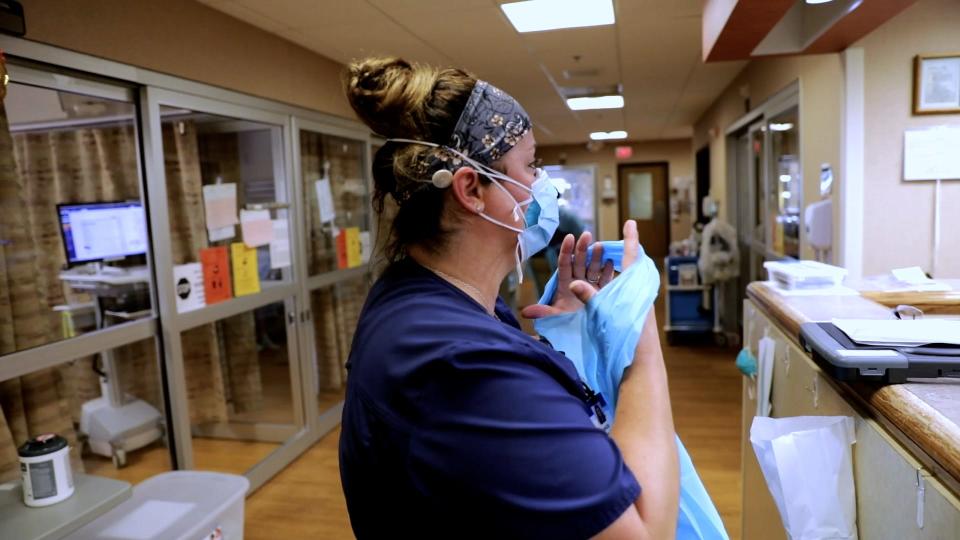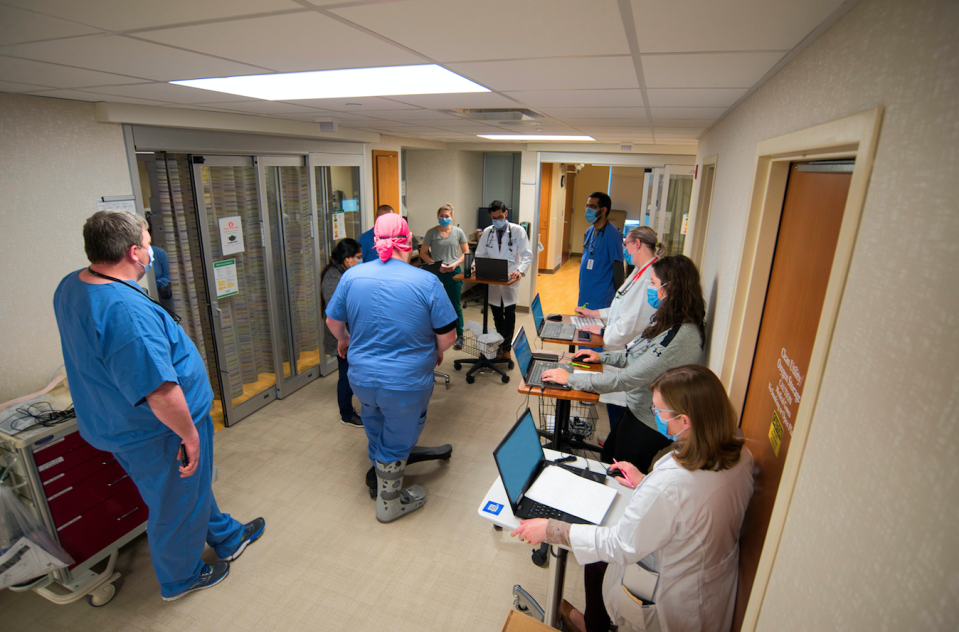'It becomes very demoralizing': Sioux Falls health care professionals are burning out after two years of COVID-19
Health care workers at local hospitals are saying that as more COVID-19 patients continue to flood into their intensive care units and emergency rooms, it’s becoming increasingly harder for staff to continue on like they have for the past two years.
The Argus Leader spoke to care providers at Avera Health and Sanford Health in Sioux Falls who agreed that the last two years of COVID-19 have taken a toll on their staff, from those getting sick to those having to leave the profession entirely due to burnout. Staff are encouraging the public to get their vaccines and stay healthy so more people can stop coming into their ICUs needing critical COVID-19 care.
“It just feels like we’ve been working the same day for the last two years,” Makayla Hagerty, an ICU charge nurse at Sanford Health said.
‘Some days it’s hard to come to work’

Taking care of COVID-19 patients over two years and the high level of stress that comes with treating the sickest of the sick has also led to some health care workers to either leave the ICU floor or the profession entirely.
Carrie Hoisington, a nursing education supervisor at the Avera Health Intensive Care Unit, said that she’s seen nurses on her team leave because it’s what’s best for their mental health.
“We can definitely see emotionally that our nurses are getting tired,” she said.
Her team relies on one another to get through the tough spots, but it’s been hard to see so much death over the past two years.
COVID-19 patients, especially the unvaccinated ones who are in the ICU, don’t get better overnight, Tony Hericks, a pulmonary critical care physician at Avera Health, said. It can take weeks or months for them to recover and it can be difficult for doctors who are used to seeing patients get better right away.
“It becomes very demoralizing at times to think about what you’re going to do to try to help that person get better and realize that you’re at the beck and call of whether their body’s going to heal,” Hericks said.

Professionals leaving has caused short-staffing at Avera and Sanford. Sanford, Hagerty said, is using more travel nurses than she’s ever seen in her six years with the hospital.
Most of the time it’s four patients to a nurse at Sanford Health but because of staffing, sometimes a nurse could be expected to take care of up to five patients, Matt Peterson, a charge nurse on the medical pulmonary unit at Sanford, explained. And COVID-19 patients keep coming into the ICU from an already full emergency room to independent clinic admissions.
“It is just always busy,” he said. “You are constantly helping your other nurses. It’s teamwork all the time.”
Great Resignation: Instead of quitting, this nurse traded South Dakota pay to become a travel nurse
The lack of community support has also impacted health care workers, and not just those treating patients, but janitorial and maintenance staff who help the hospital run.
“We've now become in some respects the enemy and looked down on,” Hericks said. “I feel bad for my colleagues and my nursing staff because we see so much more than negativity then we do positivity as far as health care goes.”
Taking care of one another
While Sanford and Avera are accepting traveling nurses to help in their COVID-19 units, nurses are constantly checking in with their team to see what they can do to help stress-wise.
“Nurses will work 100 hours a day. If you offered someone a break, they’ll probably say no, but if you kind of force them to step away and take a breather, that can be helpful,” Hagerty said. “We’re glorifying overtime and it’s just not sustainable.”

Both Hagerty and Hosington said they have great nursing teams that have been working hard for the past two years.
Hosington said that her ICU team has worked together to get through the tough times.
“We have such a good team to lead on each other and that’s really what’s been kind of holding our staff together,” she said.
More: South Dakota's first child COVID-19 death was an infant, according to Department of Health
What people can do
As COVID-19 continues to surge in the state, breaking the four-day record on Friday for active COVID-19 cases, health care workers expect the next few weeks to be extremely difficult as more people continue to get sick.
“We may not have enough nurses or doctors to take care of patients in the hospital and those that are are going to be there are already tired of working two years straight without much respite,” Hericks said.
Statewide, 349 people are currently hospitalized with COVID-19 as of Jan. 14, according to the Department of Health. There are 26,835 active cases.

All four health care workers the Argus Leader spoke to encouraged those who have not gotten their COVID-19 vaccine to do so. The majority of COVID-19 patients who aren’t doing well at Sanford and Avera are unvaccinated.
Out of the 208 COVID-19 hospitalizations at Sanford as of Jan. 11, 88% of patients in the ICU are unvaccinated and 89% of patients on ventilators are unvaccinated, according to hospital data.
At Avera, 67% of the 150 COVID-19 patents are unvaccinated, according to a spokesperson. 80% of the COVID-19 patients on a ventilator are unvaccinated while 69% of ICU patients are unvaccinated.
Follow Annie Todd on Twitter @AnnieTodd96. Reach out to her with tips, questions and other community news at atodd@argusleader.com or give her a call at 605-215-3757.
This article originally appeared on Sioux Falls Argus Leader: COVID's cost for South Dakota health care: staff shortages, burnout

 money
money 